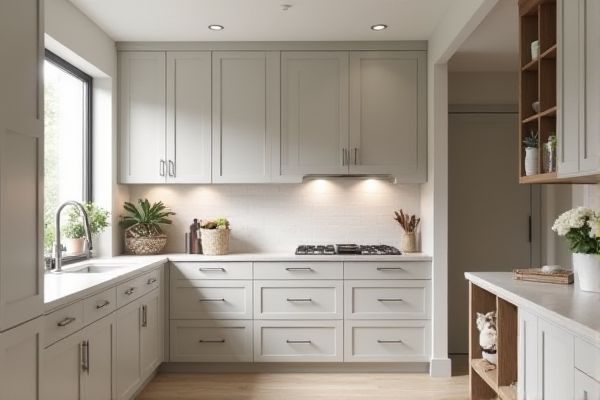
Inset cabinets feature doors and drawers that fit flush within the cabinet frame, creating a clean, custom look with visible frame edges, while overlay cabinets have doors and drawers that sit on top of the frame, providing a more modern and streamlined appearance. Understanding these key differences will help you choose the right style for your kitchen, so explore the rest of the article to make an informed decision for your home.
Table of Comparison
| Feature | Inset Cabinet | Overlay Cabinet |
|---|---|---|
| Door Fit | Doors sit flush inside cabinet frame | Doors partially or fully cover cabinet frame |
| Appearance | Traditional, custom, detailed look | Modern, seamless, clean lines |
| Durability | More durable, withstands frequent use | Less durable, edges prone to damage |
| Cost | Higher due to precision craftsmanship | Generally more affordable |
| Installation | Requires precise fitting, complex | Easier and quicker to install |
| Cleaning | More gaps, collects dust | Fewer gaps, easier to clean |
| Popular Use | Premium kitchens, traditional designs | Contemporary and budget kitchens |
Introduction to Inset and Overlay Cabinets
Inset cabinets feature doors and drawers set flush within the cabinet frame, offering a sleek and traditional look with visible cabinet edges. Overlay cabinets have doors that cover the cabinet frame partially or fully, providing a contemporary appearance with varying degrees of reveal depending on the overlay style. Understanding these differences helps you choose cabinetry that aligns with your kitchen's style and functional needs.
Definition of Inset Cabinets
Inset cabinets feature doors and drawers that fit flush within the cabinet frame, creating a smooth, built-in appearance. This design allows for precise alignment and reveals the frame edges around each door or drawer, showcasing traditional craftsmanship. Your choice of inset cabinets offers durability and a timeless, classic aesthetic ideal for detailed kitchen designs.
Definition of Overlay Cabinets
Overlay cabinets feature doors and drawer fronts that cover the cabinet frame partially or fully, creating a sleek and modern appearance. Unlike inset cabinets, where doors fit flush within the frame, overlay cabinet doors sit on top of the frame, allowing for larger door sizes and varied overlay levels such as full, partial, or even reduced overlay. Your choice between inset and overlay cabinets impacts both the visual style and the ease of installation for your kitchen or bathroom cabinetry.
Key Differences Between Inset and Overlay Cabinets
Inset cabinets feature doors and drawers set flush within the cabinet frame, creating a clean, traditional look with precise craftsmanship. Overlay cabinets have doors and drawers that partially or fully cover the cabinet frame, offering various styles such as partial, full, or flat overlays to maximize storage space. Key differences include aesthetic appeal, installation complexity, and maintenance needs, with inset cabinets generally requiring more precise alignment and custom work compared to the more versatile overlay options.
Aesthetic Appeal: Inset vs Overlay
Inset cabinets offer a classic, streamlined aesthetic with doors fitting flush inside the frame, creating clean, precise lines that enhance traditional or craftsman-style kitchens. Overlay cabinets provide a more contemporary look by covering the cabinet frame partially or entirely, allowing for larger door surfaces and a sleek, seamless appearance ideal for modern designs. Your choice between inset and overlay cabinetry significantly influences the overall style, with inset emphasizing craftsmanship and overlay highlighting bold, minimalist appeal.
Cost Comparison: Inset vs Overlay Cabinets
Inset cabinets generally cost more than overlay cabinets due to their precise craftsmanship and custom fit, often increasing your overall cabinetry budget by 10-30%. The intricate design of inset cabinets requires higher-quality materials and labor, making them a premium option compared to the simpler installation and lower material costs of overlay cabinets. Choosing overlay cabinets can be a cost-effective solution while still offering a stylish appearance suitable for various kitchen designs.
Durability and Maintenance Considerations
Inset cabinets, with doors set flush within the cabinet frame, offer superior durability due to their solid construction and precise craftsmanship, making them less prone to warping over time. Overlay cabinets feature doors that partially or fully overlap the cabinet frame, which can be easier to maintain with simpler hardware and fewer alignment issues but may be more susceptible to wear and hinge stress. Your choice depends on whether you prioritize long-term robustness or easier day-to-day maintenance in your kitchen design.
Installation Process for Each Cabinet Style
Inset cabinets require precise framing and detailed measurements during installation to ensure the door fits flush within the cabinet frame, demanding skilled craftsmanship. Overlay cabinets are easier and quicker to install, as the doors simply overlay the cabinet box, allowing for some adjustment to align doors and gaps. The installation process for inset cabinets is typically more time-consuming and costly, while overlay cabinets offer greater flexibility and simpler mounting options.
Pros and Cons of Inset Cabinets
Inset cabinets offer a sleek, traditional look with doors and drawers set flush within the cabinet frame, providing a clean and precise appearance. They are highly durable and easy to align, but typically come at a higher cost due to the craftsmanship involved and can slightly reduce storage space because the doors sit inside the frame. Your choice may hinge on valuing style and precision over maximized storage capacity and budget constraints.
Pros and Cons of Overlay Cabinets
Overlay cabinets offer a sleek, modern appearance by partially covering the cabinet frame with door fronts, providing a wider opening and easier access to the interior. You benefit from increased design flexibility and a more affordable price compared to inset cabinets, but the exposed edges of the cabinet frame can accumulate dust and may result in less precise door alignment over time. Maintenance is generally simpler, though overlay cabinets might lack the traditional, flush look that some homeowners prefer.
 homyna.com
homyna.com